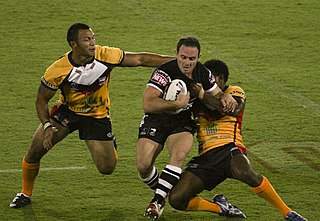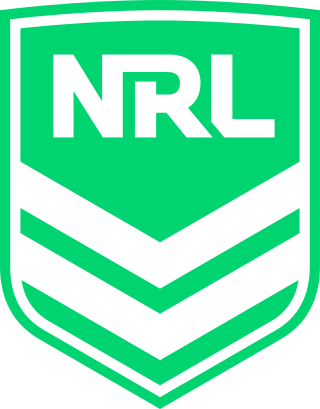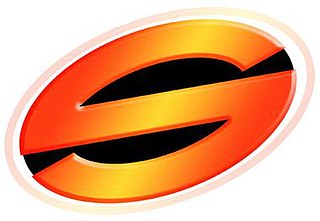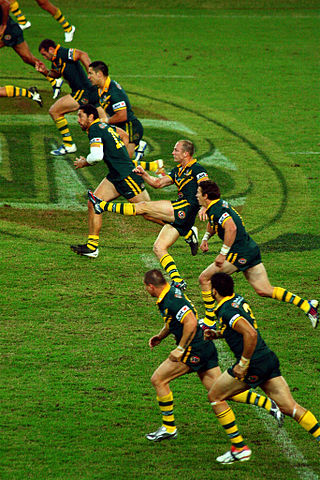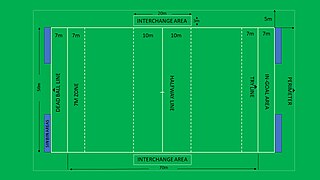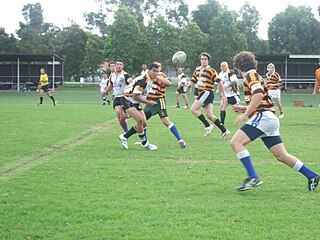Touch worldwide
Australia
Touch is played in every Australian state and territory, and is particularly popular in the rugby league and rugby union strongholds of Queensland, New South Wales and the ACT. There are currently over 700,000 registered Touch players, 500,000 school children, and up to 100,000 casual players playing the sport. [16] The peak governing body was formed in 1978 as the Australian Touch Football Association. In 1981 the word "football" was dropped from the name and the organisation became the Australian Touch Association. After a restructure and merger of the national body with the state-level governing bodies (except the Queensland and New South Wales associations) in 2004, the word "football" was re-incorporated into the organisations new name - Touch Football Australia. [17]
From 1997 until 2018, Australia's main domestic competition was the National Touch League (NTL). Thirteen permits, representing all parts of Australia, compete in open-age, under-20 and over-age (Masters) divisions in men's, women's and mixed categories. The permits were originally designed to equalise competition between the traditionally strong Touch states of Queensland and NSW, and the remainder of the country. The Elite 8 series, an additional competition played at the same time as the NTL, was created in 2013 to provide a further elite domestic level to the sport. As a result, the 20 Years & Under division for that year's NTL was removed. The Elite 8 was eventually replaced in 2018 by the NRL Touch Premiership though the NTL continues.
A youth version of the National Touch League, formerly known as the National 18's and now known as the National Youth Championships, is held annually. The original National 18's event included only an 18 Years & Under division but was expanded and renamed in 2013 to accommodate the 20 Years & Under division after it was removed from the NTL as a result of the Elite 8 Series. The 20 Years & Under division reverted back to the NTL in 2014 where it has remained since. The event has simultaneously been held with the National Schools Cup, an event featuring the best school-based teams from each state. In 2020, the COVID-19 pandemic affected National Youth Championships was run simultaneously with the Queensland Junior State Championships to expand the event to include 12 Years & Under, 14 Years & Under, and 16 Years & Under, a format which was further expanded in 2021 when entry to those age divisions was opened to teams from outside of Queensland.
The first state of origin series between the stronghold states of Queensland and New South Wales was played in Port Macquarie, New South Wales in 1995 and has been played every two years since. The series originally featured a single Men's and Women's divisions, but was expanded in 1999 to include a Mixed division, and age-restricted divisions. [18]
School Sport Australia conducts an annual National Championships, which includes division for both Primary School (Under 12) and Middle School (Under 15) sides. The location of the event rotates between states each year, and most Australian States and Territories enter Boys and Girls teams in every division.
Touch Football Australia (TFA) and the National Rugby League (NRL) signed a memorandum of understanding in August 2013, bringing the two entities together to form a partnership to develop the sport across both codes. The agreement recognised the similarities between both Touch and Rugby league and that the significant benefits to both through a dual-track pathway. [19] The agreement resulted in the creation of a unified "NRL Touch Football" brand in Australia, which resulted in a major profile and funding boost for the sport within the country, including the signing of a commercial partnership agreement between the two entities and the principle "whole of game sponsor", initially Harvey Norman and later Doordash.
In May 2018, under the NRL Touch Football partnership, the organisation launched the NRL Touch Premiership, a domestic home and away series played as curtain raisers to NRL matches. The initial teams were drawn from the Elite 8 Series and aligned to NRL clubs. [20]
Austria
The Touch Austria Association became an associate member of F.I.T (Federation International Touch) in October 2009 with 3 official member clubs (Touch Rugby Vienna, ACC Touch, Touch Voralberg). 2009 saw the establishment of the Austrian Touch League (ATL) plus the first ever national Touch teams (Mixed and Men's) that competed in the 2009 Mainland Cup. Touch Austria also sends teams to contest regular events in other tournaments in Europe.
Chile
Touch has been played in Chile since 1998 by initiative of foreign residents in the country, where Chilean players and teams were added, giving way to the creation of the official body Touch Rugby Chile.
Currently in Chile, touch is played in different cities:
Santiago: Santiago Touch Rugby league, which brings together 16 teams and played in mixed category.
Senior Touch league: which brings together 7 teams, it is played only by men over 40 years, once a month. The league adopted the official Touch rules in 2016, being supported by referees who belong to the Federation of Chile Touch.
Schools: It is practiced in several schools where rugby is played.
Touch is also developing in regions outside of Santiago like Rancagua and Paine.
Chile participates in the following international tournaments:
Torneo Trasandino: This tournament has been held since 2014 in the cities of Cordoba, Mendoza and Santiago (three tournaments a year), with the participation of teams from the cities mentioned, plus Rancagua and Paine.
USA Touch Nationals & International Club Open. This league is held annually in the United States, with the participation of several states of that nation plus other countries like Chile, which is attending since 2012.
Touch World Cup. The last edition was 2015 in Australia. Chile participated for the first time, achieving an outstanding participation: Bronze group winners and ranked No. 13 of the FIT Open Mixed Division.
England
The England Touch Association (ETA) was formed in 1995 and by the end of 2021 had grown to 106 member clubs and over 2,000 individual members. [21] The ETA oversees both elite and development National Touch Series events in the summer for single-gender and mixed teams. In addition, the annual Touch Nationals provides competition for representative regional sides in open, juniors, seniors and masters divisions. All ETA tournaments are live-streamed on YouTube. The ETA's national high performance programme includes six England men's squads, four women's squads and two mixed squads.
France
Touch France is the national association in charge of the development of the Touch in France. The French Men's Over 30s is the first French team to win an international competition by winning the 2012 Euros in Treviso. In the very same category, France Men's Over 30s won a bronze medal in Putrajaya, Malaysia in the 9th Touch Football World Cup.
Germany
Touch is played in Germany since 2003 by round about 500 active players. In 2005, the official national governing body Touch Deutschland Sportverein (TDSV) was founded, which is a full member of the FIT and has sent teams to the European Cup and World Championships. Clubs now exist in Berlin, Bonn, Frankfurt, Freiburg, Gießen, Hamburg, Heidelberg, Cologne (Köln), Leipzig, Munich, Osnabrück, Paderborn and Rüthen. The German Championships are held every year since 2005. Record title holder is the club from Munich.
Italy
Touch Rugby Italia (TRI) is the official body recognised by FIT for the development of the Touch in Italy. Currently there are 14 teams affiliated to TRI. TRI send regularly national teams to International Events in Europe
Japan
Japan Touch Association (JTA) is the official body recognised by FIT for the development of the Touch in Japan. In 2016, there are 32 clubs recognized by JTA, while 55 teams played for Tokyo Touch tournament. Assuming the recognition rate is 40%, it is estimated 2000 active players in 110 clubs.
Malaysia
Touch Malaysia (TM) is the official body for the sport in Malaysia and the Malaysian member of the Federation International Touch (FIT) – the International Federation. [22] A number of touch football teams can be found in Malaysia including the Penang Panthers. The Panthers were founded in 2011 by Christopher Woodhams, a Birmingham born philanthropist and educator. Matt Lee, a star player in Australia, helps run the club. Matt took the Asian Club Championships, held in KL in June 2013, by storm and dominated the opposition with his pace and shrewd passing abilities. The Panthers were the best placed Malaysian team at the Asian Club Championship and were the Men's Masters runners up. [23]
New Zealand
Touch New Zealand [24] is the governing body recognised by the FIT and is charged with developing and grow the game in New Zealand.
Touch in NZ is made up from the 19 provincial regions - Te Tai Tokerau, Auckland, North Harbour, Counties Manukau, Thames Valley, Waikato, King Country Rugby Football Union, Bay of Plenty, Hawkes Bay, Tairāwhiti, Manawatu, Taranaki, Wanganui, Horowhenua-Kapiti, Wellington, Nelson Bays, Christchurch, Otago and Southland. Touch is one of the country's most popular summer sports.
Just over 100,000 registered module players compete around the country; 3500 of these players represent their respective regions at national events (2023 Opens Nationals, Youth Nationals, Masters Nationals, Secondary Nationals).
New Zealand will be competing in the upcoming 2024 World Cup in Nottingham England sending a contingent of 11 teams
The current CEO of Touch New Zealand is Joe Sprangers [25]
Scotland
Touch has been played in Scotland since 1991 in informal leagues in Edinburgh and Glasgow. The sport soon spread to Aberdeen with a well established league forming soon afterwards.
In 2005, the Scottish Touch Association (STA) was formally constituted as the governing body to help develop the sport. By 2007 the association had welcomed new participants from Dundee, Perth and Stirling to join existing leagues, held its first formal national championships, trained over 150 referees and won the tender to host the 2011 World Cup in Edinburgh.
Singapore
Touch Singapore (TSG) is the governing body recognised by FIT for Touch Football. Established in 2017, Touch Singapore hosts two league competitions every year with over 95 teams entering across 12 category divisions. Singapore has won bronze at two Touch World Cups in 2011 & 2015 in the Women's Open category. There are over 5,000 players playing competitively and socially in Singapore with 2,000 registered players in the league competitions. TSG also host the Singapore International Touch Knockout tournament which see clubs from all over Asia competing over a two-day competition.
South Africa
Touch in South Africa is overseen by the [South African Touch Association, and is often known as 'Six Down'. South Africa has had national representation at all Touch World Cups since 1995. There are already over 6,000 registered players in South Africa.[ citation needed ]
Switzerland
Touch Switzerland (TS) is the official body recognised by FIT for the development of Touch in Switzerland. Switzerland has competed in all European Championships since 2006 and in the 2007 and 2011 World Cup. Switzerland sends teams to contest regular events in other tournaments in Europe. The biggest accomplishment so far is winning the Mainland Cup in Heidelberg in 2009 – coming third in the Women's Open and first in the Men's Open divisions. As of 2020, there are TS-affiliated clubs in Baden, Bagnes, Basel, Bern, Egg, Geneva, Lausanne, Lucerne, Zug and Zurich. [26]
United States
There are touch communities in Fort Lauderdale, Floria, Orlando, Floria, West Palm Beach, Florida, Portland, Oregon, Phoenix, Arizona, Los Angeles, San Francisco, Washington, D.C., New York City, Chicago, Houston, Dallas, San Diego, Boston, and Sandy, Utah. The current President of United States Federation of Touch is OJ Hawea.
Thailand
Touch is played regularly in various parts of Thailand, mostly by expats, many of whom are teachers living in Thailand. Touch is particularly popular in Phuket and Bangkok, and is also popular with Thai locals who are gaining an interest in rugby yearly.


